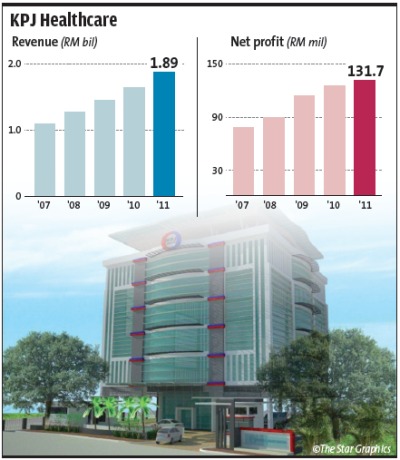KPJ Healthcare Bhd is on overdrive in its search for perfect-fit acquisitions as well as building new hospitals. “The name of the game is expansion. The private healthcare industry in Malaysia has been coming up very strongly. KPJ and other players are on the expansion mode. The demand is there because of the affluent society and good economy,” managing director Datin Paduka Siti Sa’diah Sheikh Bakir tells StarBizWeek.
She says the catalyst that pushed healthcare in Malaysia is insurance. “Companies, employers and individuals buy insurance. Those are the catalysts. People are investing in their health. They are willing to buy health insurance. They know that if something happens to them, they are covered. So that’s why the business is growing.”
Siti Sa’diah says KPJ grows about 10% to 15% annually and opines that the private healthcare industry is growing more or less at that rate as well.

Siti Sa’diah: ‘We hope to conclude at least one local acquisition and one abroad by year-end.’
A study by Deloitte South-East Asia reveals that private healthcare across South-East Asia is expected to see higher growth as a result of the region’s robust economies, urbanisation and aging population.
KPJ, which is celebrating its 30th anniversary, is currently the country’s largest private healthcare group operating 21 hospitals locally with two hospitals in Indonesia and a retirement and age-care resort in Australia.
“We became aggressive (with the expansion plan) in 2004 and 2005 because of our Al-‘Aqar Healthcare Real Estate Investment Trust (REIT), which allowed us to unlock the value of our assets. The money that came in from the REIT has allowed us to reinvest, and thus, we become an asset-light company,” she says.
Despite its extensive network, Siti Sa’diah says KPJ is keen to build on its extensive network and is currently assessing some offers, locally and internationally.
“We hope to conclude at least one local acquisition and one abroad by year-end.”
She did not reveal the size of the acquisitions. She adds that KPJ has been looking for potential acquisitions continuously. ”We’re ready for two acquisitions a year and also to build two hospitals a year.”
“We are keen on acquisitions… not greenfield. We are more interested in Asean. We have learning curves from Dhaka, Bangladesh and some experience in Bangkok, so we know what the markets are like.”
Additionally, Siti Sa’diah says local standalone hospitals are also potential targets. She said these standalone hospitals could leverage on KPJ’s extensive network as well as cost savings benefits because training and procurement would be centralised.
The healthcare group has earmarked more than RM1bil to set up nine more hospitals throughout the country in its effort to widen its healthcare services.
The nine projects are at different stages of development and they include the five projects listed under the healthcare sector of the Economic Transformation Programme (ETP).
The five projects announced under the ETP will involve initial investments of about RM760mil and will add 822 beds to KPJ’s existing capacity of more than 2,600 beds.

“We’re currently assessing the bidders for the hospital tender in Pahang. The Perlis hospital will be tendered out soon. We’re also waiting for approval of our plan for Johor Baru’s Bandar Dato Onn hospital.”
By 2015, KPJ will have 30 hospitals from the current 21.
Besides the new hospitals, KPJ is also adding capacity to existing hospitals and relocating its facility in Sabah.
“We are building two additional floors to accommodate 50 beds at the Tawakal hospital and another 50 beds at the Damansara hospital. We have 2,600 beds now and it will increase to 3,000 once the expansion is completed,” she adds.
Occupany rates at the group’s hospitals are averaging above 65% .
“Some hospitals have a higher occupancy rate and some slightly lower. But on average it is above 60%. I am happy with the performance.”
In the past few years, KPJ’s financials have remained resilient even in the recent economic downturn. For the financial year ended Dec 31, 2011 (FY11) KPJ’s net profit grew 10.8% to RM131.7mil while its revenue increased 14.5% to RM1.89bil.
Siti Sa’diah sees KPJ registering 10% to 15% growth in revenue this year as it has been performing in the past.
Despite its rapid expansion, KPJ did not need to raise any cash, she says adding that it has commercial papers and medium-term notes of RM250mil which could be utilised if necessary.
She says the group’s model of being asset-light by injecting its building and land into Al-‘Aqar KPJ REIT has also helped to unlock its value.
“These commercial papers and REIT must be planned in such a way that our cash flow is good,” she says.
Through the REIT, KPJ has managed to offload its borrowings, enabling it to consider wider options for future growth.
“That’s why our (net) gearing is low at 0.3 time,” she said. As at Dec 31, KPJ has cash and cash equivalents of RM177.3mil.
She explains that when a new hospital becomes operational, it may not become profitable immediately.
“Revenue may be there but it will be loss making for two to three years,” she says.
“Investors love us,” she says, referring to its consistent dividend payout. KPJ spent about RM200mil in capital expenditure on hospitals and RM100mil to RM150mil on hospital equipment per annum.
“We’re constantly upgrading the business.”
In a report, AmResearch said it liked KPJ’s defensive earnings profile. “Also, a step-up increase in bed capacity via a pipeline of seven new hospitals would accelerate earnings momentum to achieve our conservative three-year CAGR of 17%.
Faster-than-expected patient admission growth, coupled with a one-year hiatus from hospital expansion, has led to shrinking ready capacity. The current occupancy rate of 70% to 75% is a tad below over-crowded thresholds of 85% to 90%.
The research house adds that with a sizeable 22% market share, KPJ is Malaysia’s largest private healthcare provider with a national footprint and growing scale.
It is well-placed to capitalise on the booming and lucrative health tourism, with the doubling of the strategic existing hospital chain in Johor a focal area slated to become the primary destination for tourists.
KPJ has also seen competition intensifying in the private healthcare industry. Like KPJ, other players are also diversifying their respective offerings and expanding their networks.
“Competition is good. With the Asean Free Trade Agreement, there would be free flow of goods and services and healthcare industry is part of it. ,” Siti Sa’diah says.
Separately, KPJ is also gearing itself for medical tourism. “There are two aspects to medical tourism. First, those who come know they can get the service at competitive prices in Malaysia. Secondly, the quality is better. Of course, they don’t have to wait either. For example cardiac surgery in the United States costs US$60,000 compared with RM40,000 in Malaysia,” she says.
Medical tourism currently contributes about 5% of the group’s revenue but it is growing.
“It is more structured now. We have also signed up agents instead of waiting for individuals to come. The Malaysia Healthcare Travel Council was set up two years ago and (healthcare tourism) became part of a national key economic area.
On the 1Care healthcare plan, she says: “If the Government can put a good framework (to it) and nobody is penalised, it is a good concept. It is like a national healthcare plan. We have been waiting for it for a long time.”
Apart from its hospitals, KPJ is also looking at expanding its education arm KPJ International University College of Nursing and Health Sciences which complements its hospital operations. It hopes to achieve university status by 2016.
KPJ has a long-term plan to diversify into new markets and businessed including retirement villages and aged-care services.
“We are moving into age-care locally and have identified two sites. We are already doing acute care, so doing this for the elderly will not be so difficult,” Siti Sa’diah says.
KPJ made its foray into age-care two years ago with the acquisition of a 51% stake in Jeta Gardens, which owns and operates a 25.6ha retirement village in Queensland, Australia. While earnings contribution is minimal, KPJ sees tremendous potential.
Siti Sa’diah says the group’s age-care service in Australia is performing well.
“They are adding more facilities. There are 108 beds now and the government just approved 70 more.
“There are 32 retirement villas and we will be adding 28 more. This will come in phases. We’ll do it progressively,” she says, adding that it was also looking at re-developing the 64-acre property in Australia to include a hospital and a college.
On the setting up of age-care operations in Malaysia, she says that “the timing is right.”
“It is more acceptable now. We are currently studying two sites for our age-care business. We want to look at one site in Johor, where our hospital is so that we can attract Singaporeans.
“We are also looking at a site near our hospital in Ampang. But we have not finalised anything yet,” Siti Sa’diah says.
Currently, overseas contributions to group revenue remain below 10%.
KPJ also intends to grow its business in Indonesia where it currently operates two hospitals – RS Medika Permata Hijau and RS Bumi Serpong Damai in Jakarta.
“We want to grow in Indonesia and possibly in other parts of Asean. One hospital (in Indonesia) is performing well and Bumi Sepong Damai aims to break even by year-end. It’ll need a two to three-year gestation period,” she says.
source: http://www.biz.thestar.com.my / Home> Business / by Leong Hung Lee, hungyee@thestar.com.my / Saturday, June 16th, 2012



